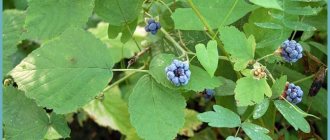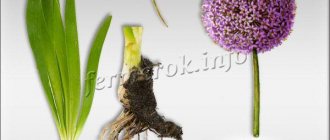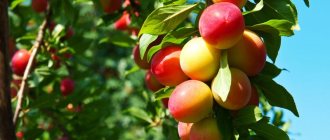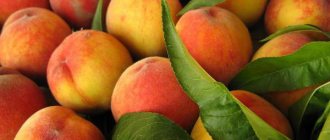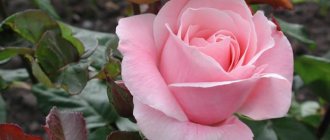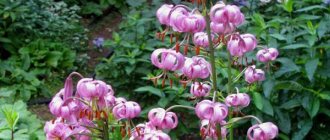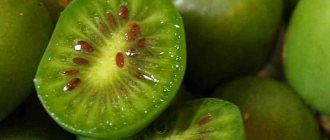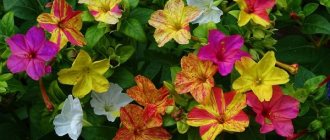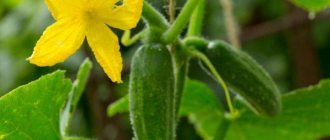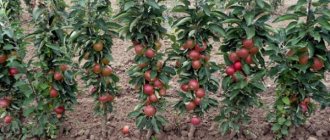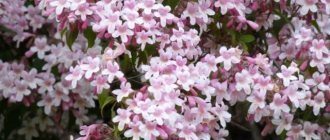Author: Natalya Category: Fruit and berry plants Published: August 03, 2016Republished: February 04, 2019Last edits: November 02, 2020
- Conditions for growing yoshta
- When to prune
- Reproduction methods
- Diseases and their treatment
- Beneficial features
What is yoshta? The Yoshta plant is a hybrid of common gooseberry, common gooseberry and black currant. The name Josta (German) is derived from the first syllables of two German words: Johannisbeere (currant) and Stachelbeere (gooseberry). The yoshta bush appeared in the 70s of the last century thanks to the many years of work of the German breeder Rudolf Bauer. However, the hybrid of currants and gooseberries, Yoshta, was prepared for industrial cultivation only in 1989. In our country, yoshta has not yet gained wide popularity, but in Western Europe it is grown everywhere.
Yoshta's appearance
Yoshta is a hybrid of gooseberry and black currant. This is a fairly large shrub with spreading branches; it can reach a height of about 1.5 m. A clear advantage of the plant is the absence of thorns on it, unlike gooseberries.
The leaves of Yoshta are dark green, large and very similar to currant leaves, but without a characteristic odor. Moreover, the foliage stays on the branches almost until the onset of frost. The flowers of the plant are bright and quite large. The plant usually begins to bear fruit after 2 years. The fruits are much larger than currants, black-violet in color, sweet and sour, ripen in clusters of several pieces.
Cultivation history
At the beginning of the 1900s, breeders decided to improve gooseberries and black currants - to make a berry, the main advantages of which were to be:
Table: expected selection acquisitions of yoshta from “parents”
| Gooseberry | Black currant |
| No thorns | Resistance to bud mite and terry |
| Productivity | Berries rich in vitamins |
| Large fruits | |
Work on the creation of such a hybrid was carried out in several countries at once: in Russia - I.V. Michurin, in the USA, Germany, Sweden, Hungary. The first attempts to cross gooseberries and currants yielded sad results: the hybrids simply died, and the survivors turned out to be completely infertile.
Only in 1970, with the help of genetic engineering and under the influence of radiation and chemicals, seedlings were produced that bore their first fruits. They were called joshta - from the first letters Johannisbeere - currant and Stachelbeere - gooseberry.
Unfortunately, the hybrid turned out to be not such an ideal berry as planned. The bush really grew large and without thorns, the leaves are like those of a gooseberry, but much larger in size. The berries are collected in clusters of 5 pieces, sweet and sour, and are inferior in vitamin C content to black currants, but are 2–4 times superior to gooseberries.
Yoshta is a hybrid obtained from crossing black currant, splayed gooseberry and common gooseberry.
The weak point of yoshta was its productivity. According to numerous observations, there are much fewer berries on the bush than currants and gooseberries, although sometimes there are reviews from amateur gardeners about a variety that produces more than 6 kg per season. And people are still afraid to eat genetically modified foods.
However, breeders have achieved resistance of this hybrid to various diseases and pests.
Beautiful and powerful bushes are simply ideal for a hedge, which grows on its own and requires virtually no pruning.
Video: briefly about the hybrid of currants and gooseberries
Basic rules for planting yoshta
- Boarding time. Planting in open soil should be done either in early spring, before the plant begins to actively grow, or in early autumn, so that the plant can take root and strengthen before the onset of cold weather (in this case, you must remember to carefully remove all leaves from the seedling without damaging the plant’s buds) .
- Place. An open area well lit by the sun is suitable for planting. By the way, some gardeners are deeply convinced that for good fruiting of yoshta and the active development of the plant as a whole, gooseberries or currants should definitely be planted next to it.
- The soil. Yoshta needs nutritious, well-drained soil.
- Selection of seedlings. When choosing a seedling for planting, first of all you should carefully examine its roots: they should have a healthy, strong appearance, and in no case be dry and weather-beaten (if you decide to try to plant such a plant, then you need it for at least a day leave the roots submerged in water). Another indicator of the viability of a seedling is the color of the plant’s bark from the inside - in a living plant it is always green. But the brown color is a sign of necrotic processes in the plant. Before planting, dried and damaged roots must be removed, and it is recommended to revive the rest by trimming them a little.
- Preparing the pit for planting. If you plan to plant a seedling in the spring, then you should think about the hole in the fall. Its size should be sufficient to freely accommodate the roots of the plant. On average it is approximately 0.5 m deep and wide. Add compost or humus, superphosphate, wood ash, and a little ordinary soil to the bottom of the pit and mix everything together. This mixture should take up about a third of the pit. Nutrient soil from the upper layers is poured from the top to half the volume of the pit and the whole thing is filled with a bucket of water.
In the spring, the soil in the hole is loosened a little, the root system of the seedling is spread over it and the plant is covered with fertile soil, carefully compacting it and compacting the tree trunk circle. The planted plant must be watered thoroughly.
If the seedling is planted in the fall, then the sequence of actions is the same, with the difference that the hole is prepared 2-3 weeks before planting.
You should also remember that it is recommended to leave a space of about 1.5-2 m between plants. If you plan to make a hedge from plants, then about 0.5 m.
- Mulching. After the soil has dried a little after watering, it is recommended to mulch it with a layer of mulch up to 10 cm. For this purpose, humus, grass, hay, straw, and peat are usually used.
- Trimming. After planting, the seedling must be pruned - this will facilitate better rooting of the plant. Pruning is done in such a way that no more than 3 buds remain on it.
How to prune yoshta in the fall
The size of the planting pit for yoshta should be such that the root system of the seedling fits in it with a margin of approximately 50x50x50 cm. The pits are prepared for planting in the fall. The distance between yoshta bushes is kept within 1.5-2 m, but if you decide to use yoshta as a hedge, then a distance between the bushes of 40-50 cm will be sufficient.
Place half a bucket of humus or compost in each hole, add half a liter of wood ash, 100 g of superphosphate and a little soil from the infertile layer and mix thoroughly.
Fill the hole to a third of the size with this consistency, then add up to half the size of fertile soil from the top layer of soil and pour a bucket of water into the hole.
This completes the preparation of the pits in the autumn.
Over the winter, the soil in the hole will settle and become stable.
In the spring, lightly loosen the bottom of the hole, place the seedling in its center, carefully straighten its roots and fill the hole with soil from the top, fertile layer, shaking the seedling from time to time so that there are no voids left in the soil.
When the hole is full, lightly compact the surface of the area around the seedling, pour a bucket of water under it, and when the soil dries slightly, mulch it with a layer of peat, humus, grass, hay or grass 5-10 cm wide.
After this, prune the seedling, leaving no more than 2-3 buds on each shoot.
When to plant yoshta
Planting of yoshta is carried out early in the spring, before the start of sap flow, or early in the autumn. The site for this extraordinary plant should be sunny and the soil fertile. They say that yoshta will grow and bear fruit well only if a currant or gooseberry bush grows nearby.
When purchasing a planting plant, you should pay attention to the quality and condition of the root system of the seedlings - it must be strong and healthy.
Dry and weathered roots may not take root in the soil. Pay attention to the bark: its “underside” must be greenish in color, not coffee-colored, otherwise you risk acquiring a dead seedling.
If you purchase yoshta seedlings in the autumn, before planting, carefully remove all the leaves from them, trying not to destroy the buds. Also remove rotten and dry roots, lightly trim healthy roots.
If it seems to you that the roots are a little dry or weather-beaten, keep them in a bucket of water for a day.
Planting yoshta in autumn
Planting and caring for yoshta in the autumn is carried out in the same order as in the spring, but the pits for it are prepared two weeks before planting.
Hybrid Yoshta - description
The yoshta hybrid is a long-lasting, powerful, spreading shrub that forms shoots about 1.5 meters high or more.
Its root system is located at a depth of 30-40 cm. Despite the fact that the yoshta bush is a direct descendant of a spiny crop like gooseberry, it does not have thorns. The diameter of the yoshta crown is 1.5-2 m.
The leaves of yoshta, huge, shiny, green, inheriting the shape of currant leaves, but not possessing its smell, stay on the bush until winter. Yoshta blooms with large, colorful flowers.
The fruits of yoshta are sweet and sour, dark with a purple tint, more like cherries, collected in a cluster of 3-5 berries. Traditionally, yoshta bears fruit from the age of two.
Yoshta berry is resistant to frost, diseases and pests, its lifespan is from 20 to 30 years.
Taking into account the origin of yoshta, we can safely say that its relatives are not only gooseberries and dark currants, but also reddish currants and snow-white currants.
From this article for us you will learn how to plant, propagate and care for yoshta, what varieties of yoshta can be grown in the middle zone, why yoshta does not bear fruit if its bush becomes very dense, what diseases and pests of gooseberries and currants can harm yoshta , and almost everything else.
Planting and caring for yoshta
- Planting: early in spring or early autumn.
- Lighting: bright sunlight.
- Soil: fertile, it is better to plant yoshta near gooseberry or currant bushes.
- Watering: the soil is often moistened to a depth of 30-40 cm.
Water consumption per 1 m² of land is 20-30 liters. - Top dressing: for the first three seasons, the annual norm of phosphorus fertilizers should be 30-40 g per year per m² of root area, and potassium fertilizer - 20 g. From the 4th season, the norm of phosphates per year per m² is reduced to 25-30 g, and the rate of potassium fertilizers increases to 25 g. Once a year, the soil under each bush is mulched with 20 kg of humus or peat, and in the autumn, a half-liter can of wood ash is added to the tree trunk of each bush.
- Pruning: in the spring (before the sap begins to flow) or in the autumn after leaf fall.
- Reproduction: vegetative - cuttings, layering, dividing the bush.
- Pests: various types of mites and aphids, moths and currant glass beetles.
- Diseases: anthracnose, goblet and columnar rust, powdery mildew, septoria, cercospora, mosaic and terry.
Read more about growing yoshta below.
Watering yoshta
Caring for yoshta involves constant and sufficient watering of the bush.
A lack of water can retard the growth and development of yoshta, which is why it is important to maintain soil moisture around the bushes throughout the growing season. When watering, the soil should be moistened to the depth of the root-forming layer - 30-40 cm, therefore the approximate water consumption for one watering is 20-30 liters per m² of area.
Watering is carried out in the morning or after sunset. It is better to pour water into specially made circular grooves 10-15 cm deep, located at a distance of 30-40 cm from the crown projection.
On the outer side of the grooves there should be restrictive earth ridges about 15 cm high. The frequency of watering depends on the moisture permeability of the soil, the weather and the presence or absence of protective mulch on the surface of the area.
Yoshta processing
Growing yoshta provides protection of the bush from diseases and pests. In order to prevent the yoshta from being affected by harmful insects and dangerous diseases, it is necessary to carry out preventive treatments of the bush once a year.
Therefore, in the spring, before the buds begin to open, and after leaf fall, when the plants go into dormancy, it is treated with one percent solutions of Bordeaux water, copper sulfate, Nitrafen or seven percent urea.
The last product is preferable, since, in addition to protecting against pests and insects, it also performs the function of feeding the plant with nitrogen fertilizer. Wait until the temperature in the garden rises above 5 ºC and start spraying the bushes.
Growing yoshta
How to grow yoshta? Feeding and caring for yoshta is no more difficult than feeding currants, and much easier than caring for gooseberries due to the presence of thorns. Activities for caring for yoshta come down to loosening the soil around the bushes, weeding, constant watering and fertilizing, as well as protecting the bush from pests and diseases.
The first loosening of the site is carried out in April to a depth of 4-6 cm in the bite zone and 8-10 cm in the row-spacings.
Loosening is carried out at least once every 2-3 weeks, but if you have mulched the area, then you will have to water, loosen and weed the soil much less often.
In addition, mulching creates suitable conditions for the development and nutrition of shrubs. The best mulch for yoshta is humus and peat.
Try to keep the soil around the yoshta bushes in a slightly wet and loose state and prevent the appearance of weeds.
Feeding yoshta
Planting and caring for yoshta involves mulching the area with peat or humus. Each bush requires up to 20 kg of organic matter as mulch, which protects the soil from rapid drying out and cracking and provides nutrition for the plant.
In the first three years of life, the annual norm of mineral fertilizers for each m² of plot with yoshta is 30-40 g of superphosphate and 20 g of potassium sulfate. From the 4th year, the rate of potassium fertilizer increases to 25 g, and the rate of phosphates decreases to 25-30 g per m².
In the fall, a half-liter jar of wood ash is poured under each yoshta bush.
Pruning yoshta in spring
In the spring, sanitary pruning of yoshta is done: broken, unhealthy shoots are removed and those that have frozen over the winter are shortened to healthy tissue.
Yoshta does not need formative pruning, but over the years it is necessary to shorten branches that are 7-8 years old, leaving only segments with 6 buds.
When to prune yoshta
Pruning of yoshta is carried out in the spring, before the sap begins to flow, and in the autumn, after the leaves fall.
Pruning yoshta in autumn
Every autumn, when the leaves have fallen and the bushes and trees go into a dormant period, sanitary pruning is carried out, cutting out the shoots affected by the glass, broken and thickening the bush, and the healthy branches of the yoshta are shortened by a third.
Yoshta: planting and care, pruning and propagation
NatalyaCategory: Fruit and berry plants
What is yoshta?
The Yoshta plant is a hybrid of common gooseberry, common gooseberry and dark currant.
The name Josta (German) is formed from the first syllables of two German words: Johannisbeere (currant) and Stachelbeere (gooseberry).
The yoshta shrub appeared in the 70s of the last century thanks to the long-term work of a breeder from Germany, Rudolf Bauer. But for industrial feeding, the hybrid of currants and gooseberries, Yoshta, was prepared only in 1989.
In our country, yoshta has not yet gained wide popularity, but in Western Europe it is grown everywhere.
VIDEO ON THE TOPIC:
Source: https://cvetovodov.pro/kak-obrezat-yoshtu-osenyu/
Yoshta care
Yoshta is undemanding in care, so if you follow some simple rules, you are guaranteed to get a good harvest of tasty and healthy berries:
- periodic loosening of the soil in the tree trunk circle
- timely weeding
- fertilizer - if the tree trunk circle is mulched with peat or humus, this will serve as an additional source of plant nutrition. In addition, in the first three years the plant especially needs potassium and superphosphate, and the total amount of potassium needed is two times less than superphosphate. In subsequent years, both potassium and superphosphate will be needed in equal proportions. In the fall, it is recommended to apply wood ash to the plants.
- timely and sufficient watering - it is done in the morning or evening, after sunset, in such an amount that moisture penetrates to a depth of about 0.5 m. The soil in the tree trunk circle should always be a little damp. Some gardeners practice watering directly into ditches that are dug near the plants. The frequency and volume of watering depend on many factors, for example, the weather, the degree of soil drainage, and the presence of mulch on the site.
- prevention of diseases and pest damage - it is recommended to carry it out either in early spring, until the plant has fully awakened and began to grow, or in late autumn. Effective drugs that can protect your yoshta from diseases and pests are Bordeaux mixture, copper sulfate, nitrafen, urea (which, by the way, is a source of nitrogen for the plant). It is important to remember that treatment should not be carried out under any circumstances if the air temperature drops below 5 degrees Celsius.
- timely and correct pruning - in the spring, before the yoshte buds begin to activate, sanitary pruning is carried out - all affected, deformed, frostbitten and injured branches are removed to the extent of healthy tissue. The plant does not need formative pruning. But in adult plants, branches that are more than 8 years old are recommended to be shortened to 6-7 buds.
Sanitary pruning, carried out in the fall, after the foliage has fallen, consists of removing diseased and injured branches, as well as those branches that will thicken the crown. It is recommended to shorten the remaining branches by a third of the length
Beneficial features
Thanks to the content of vitamins and minerals contained in this berry, we can talk about the benefits it brings to humans:
- Vitamin C, contained in huge quantities in yoshta, has a beneficial effect on human immunity. Therefore, doctors recommend eating berries for the prevention and treatment of various colds.
- It increases the level of hemoglobin in the blood, so it is recommended to use it in the treatment of anemia.
- Helps normalize the functioning of the gastrointestinal tract. Recommended for diarrhea, constipation and other types of stomach disorders.
- Doctors advise hypertensive patients to eat yoshta berries, first mixing them with honey.
- Phytoncides, which are part of the fruit, help not only in the fight against colds, but also relieve various inflammatory processes in the body, and also destroy microbial infections.
- The beneficial properties of yoshta also lie in its rich mineral composition. For example, the presence of vitamin P, as well as berry anthocyanins, help improve blood circulation and strengthen blood vessels.
- Since the berry contains a small amount of sugar, it is useful for people suffering from diabetes.
- Very often, yoshta fruits are introduced into the diet of people who suffer from obesity or are simply trying to bring their figure back to normal. After all, the berry helps speed up metabolic processes and also burns fat reserves.
- When consuming yoshta, the excretory system is stimulated, as a result of which toxins and radionuclides are removed from the body.
Tip: Yoshta fruits can be stored for a long time if they are frozen in the freezer or dried in a special electric dryer. At the same time, all its beneficial substances are preserved.
However, there are some contraindications. People who are allergic to vitamin C, as well as those diagnosed with a tendency to form blood clots, should not consume this berry. Experts also recommend avoiding consuming yoshta for diseases such as ulcers and colitis, as well as if the body reacts negatively to eating black currants or gooseberries. Lovers of these tasty and healthy fruits should also take precautions to eliminate the risk of developing an allergic reaction.
You can find out interesting information about how to properly care for yoshta by watching the video:
Useful yoshta
Yoshta is a hybrid of currants and gooseberries, characterized by large berries and high resistance to adverse environmental conditions and pests. The berries of the bush are black with a purple tint and resemble currants. While in taste they are similar to gooseberries.
- Characteristics of Krondal
- Bush propagation
- Selection and preparation of a landing site
- We also recommend reading
- Planting bushes
- Plant care
- Pruning and crown formation
Show all content
Pests and diseases of yoshta
Diseases and their treatment
You can get detailed information about what diseases can affect yoshta and how to fight them in the article about diseases and pests of currants posted on the website. In this article of ours, we will list the most common yoshta diseases and briefly describe what measures are best to use to combat them. So, yoshta diseases: anthracnose, goblet and columnar rust, powdery mildew, septoria, cercospora, mosaic and terry.
- Timely spring care of raspberries will bring a rich harvest
Mosaic and terry disease are incurable, so diseased specimens must be immediately dug up and burned, and fungal diseases can be treated with fungicides - Fundazol, Bayleton, Maxim, Topaz, Skor and similar drugs. But the best protection of plants from diseases is compliance with agricultural practices and preventive treatments.
Pests and their control
Among the pests of yoshta are the same insects that damage all varieties of currants and gooseberries: different types of mites and aphids, moths and currant glass beetles. It is best to use insecticides against these pests - Agravertin, Akarin, Actellik, Decis, Biotlin, Kleschevit and others.
Characteristics of Krondal
Yoshta - the description of this shrub combines the features of currants and gooseberries. Krondal owes its appearance, pleasant aroma and high content of ascorbic acid to black currants. Unlike gooseberries, yoshta has no thorns. In addition, the bush has beautiful, large, openwork leaves. They do not fall off for a very long time and do not have the characteristic smell of currants.
What is yoshta? This is a perennial shrub that is practically not susceptible to any diseases or pests. It does not require special care and is incredibly unpretentious to environmental conditions. The bush can grow up to 2 m or more. To get a good harvest, the plant requires a lot of space so that nothing interferes with its development.
The first harvest can be obtained already 2-3 years after planting in a permanent place. And the total duration of fruiting is up to 15-20 years.
Advantages and disadvantages
The hybrid bred by the Germans turned out to be not as good as the breeders dreamed of, who wanted to get the ideal crop. Yoshta, along with its advantages, has a number of disadvantages.
Yoshta contains less vitamin C than currants, but 2-4 times more than gooseberries - approximately 1000 mg per 100 g of berries.
Pros:
- powerful bushes can serve as a hedge - dense and not requiring special care, including special pruning;
- ease of picking berries due to the lack of thorns;
- resistance to diseases and pests;
- sweet taste of fruits with slight sourness;
- long-lasting and transportable fruits;
- rapid adaptation to the environment;
- low maintenance requirements;
- ripe berries continue to stay on the branches and do not fall to the ground.
Minuses:
- low yield (half that of gooseberries);
- genetically modified product - for many gardeners this factor is important;
- the bush requires significant space to grow;
- refers to partially pollinated plants.
You can see what Yoshta looks like, as well as learn about its advantages, in the following video:
Bush propagation
If you need yoshta, planting and caring for the plant will provide a good harvest of large vitamin-rich berries.
Propagation of krondal is not difficult even for novice gardeners. At home it is done as follows:
- Gooseberry-type layering. To do this, you need to dig the twig into the ground, leaving the top on the surface of the soil. Within 1-2 months, roots will begin to form, and after a few more months you can safely disconnect it from the bush and plant it in a permanent place.
- Layerings according to the type of currant. It is characterized by deeper burying of the branch - 10-15 cm. The rooting period lasts much longer, up to 1 year. However, this method is more reliable and allows you to get the first test harvest the very next year after transplanting.
- Chinese cuttings. The branch is placed in a longitudinal groove to a depth of 10-15 cm. As the shoot grows, it is gradually sprinkled with soil. With regular watering, a shoot will grow from each buried bud that can be used for transplantation. The disadvantage of this method is that this plant will enter the fruiting stage only after 4-5 years, but up to 10 seedlings can be obtained at the same time.
- Dividing the bush. If replanting is necessary, the crondal is dug up completely and separated into separate branches. In this case, you need to ensure that each part is provided with a good root system. It is quite difficult to break a bush, so it is best to use an ax, which will greatly facilitate the process. A good harvest can be obtained next year, since this method provides an almost 100% guarantee of successful engraftment of an adult bush.
- Lignified cuttings. Pruning yoshta, carried out in the fall, provides a lot of material for further reproduction. The branches need to be cut 15-20 cm long and planted in the ground, leaving no more than 1 bud on the surface. Unfortunately, this method is not very effective, because plant waste is used for propagation. However, with its help you can get several good bushes. A positive result is observed in 50% of all cases.
- Green cuttings. The main condition for successful propagation when using this method: the cutting should be cut off near the trunk itself, along with the heel. The shoot is treated with heteroauxin, planted in the ground and covered with a jar. It has high efficiency and good results in obtaining cuttings for planting.
Yoshta Reproduction
Reproduction methods
Like currants, yoshta is propagated by layering, cuttings and dividing the bush. As you can see, in amateur gardening, only vegetative methods are used to propagate yoshtas.
Dividing the bush
The yoshta bush is divided in the fall and only when it becomes necessary to replant it. Reproduction and planting of yoshta is carried out as follows: the bush is dug up, the roots are cleared of soil, the plant is divided into parts with a sharp knife or pruning shears, each of which should have developed roots and 1-2 strong shoots, the cuts on the roots are treated with crushed coal, after which the divisions seated in pre-prepared places.
Reproduction by layering
For this method of propagation in the spring, as soon as the soil warms up, well-developed biennial or annual branches are placed in 10 cm deep grooves made in advance in loosened soil, secured with metal hooks and, having pinched the tops remaining above the ground, sprinkled with fertile soil. As soon as the layerings develop shoots 10-12 cm high, they are half covered with earth. After 2-3 weeks, hilling is repeated to the same height. In the fall, or even better next spring, the rooted cuttings are separated from the mother bush and from each other and planted in a permanent place.
In addition to horizontal layering, vertical and arcuate layering can be used in the propagation of yoshta.
Reproduction of yoshta by cuttings
This propagation method has two options: you can use green cuttings for rooting, or you can use semi-lignified ones. To harvest woody cuttings, mature shoots from two to four year old branches are selected. It is better to do this in the fall, in the second half of September: the cuttings planted for rooting have time to take root and winter normally, and in the spring they grow together. The cuttings should have 5-6 buds, 15-20 cm long. Do not use the immature shoot tip for rooting.
Plant the cuttings in dug up soil at an angle of 45º at a distance of 60-70 cm from each other, leaving only two buds above the ground, the lower of which should be at surface level. Compact the soil around the cuttings, water it and mulch with peat. Caring for cuttings consists of watering, loosening the soil and removing weeds, especially in the first month after planting.
For green cuttings, on the contrary, apical cuttings 10-15 cm long are cut, from which the lower leaves are removed, and the two upper pairs are left, but shortened by a third. Green cuttings can be planted throughout the summer from June to the first days of September. Prepare a cold greenhouse for the cuttings in advance.
Make a light cut above each bud of each cutting, and several cuts in the lower part, place the lower cuts of the cuttings for half a day in a root-forming solution, then rinse them in clean water, plant them in a greenhouse almost close to each other at an angle of 45º and water through a fine sieve, then cover with a transparent lid. There should be a distance of at least 15-20 cm between the lid and the cuttings. At first, do not lift the lid: there should be humid air in the greenhouse and a temperature of at least 20 ºC, but as soon as the temperature rises to 25 ºC, start lifting the lid daily for ventilation.
If you do everything correctly, it will take 3-4 weeks for the cuttings to root, after which you can begin hardening procedures, removing the lid from the greenhouse every day and gradually increasing the duration of ventilation. As soon as the cuttings are strong enough, remove the lid from the greenhouse completely.
The survival rate of green cuttings of yoshta is very high. The hardened cuttings are transplanted into a school for growing and, as soon as they take root in the open ground, they are fed with 30 g of saltpeter dissolved in a bucket of water. Loosen the soil in the garden bed, remove weeds, keep the soil loose and slightly moist, and next spring transplant the seedlings to a permanent location.
Selection and preparation of a landing site
The yoshta bush is a light-loving plant. When choosing a place to plant, you need to give preference to a flat and open area. It is advisable that it be well lit and not shaded by trees. Like any agricultural crop, krondal loves fertilized soil, because the speed of growth, quality and quantity of the harvest largely depend on the composition of the soil. Of all the microelements, the most important for yoshta is potassium. Therefore, it is imperative to enrich the earth with it.
We also recommend reading
If you decide to plant krondal in the spring, the hole should be prepared in advance, in the fall. It should be quite large in size so that all the roots can easily fit in it. Therefore, its dimensions should be at least 50x50x50 cm. When planting bushes to produce berries, you need to maintain a certain interval between them - at least 1.5-2 m. This is necessary so that the plant feels free and at ease. And only in the case when they plan to use the yoshta as a natural fence, the interval between the bushes can be reduced to 0.5 m.
Organic and mineral fertilizer should be added to the finished pit - at least 5 kg of humus or compost, 0.5 liters of wood ash and 100 g of superphosphate. Mix all components well with the addition of infertile soil taken from the bottom of the pit. The fertilizer should fill about 1/3 of the hole, after which fertile soil is added to half and a bucket of water is poured. Over the winter, the soil will settle a little and become compacted. Preparation of planting holes in the spring is carried out in the same way, the main condition is that they need to be dug and fertilized at least 2 weeks before the planned planting of seedlings.
To ensure good pollination of yoshta flowers, you need to ensure that currants and gooseberries grow nearby.
Yoshta: features, planting, pruning, feeding, reproduction
jjjjjjjjjjjjjjjjjjjjjjjjjjjjjj
It is a perennial thornless shrub, a hybrid of blackcurrant and gooseberry . The bushes are powerful and spreading. They have great growth vigor and form shoots 1.5 m or more in height.
The leaves are shaped like blackcurrant leaves, but without the aroma. The berries are black, with a purple tinge, have a very dense skin, and are reminiscent of a dark gooseberry in size and shape. Yoshta practically never gets sick. Yoshta's flowers are large, 3–5 in a raceme.
The berries are black, oval-shaped, large. They ripen at the end of July and do not fall off until late autumn. The berries are larger than currants. They have a pleasant, sweet and sour taste, reminiscent of black currants and gooseberries, with a slightly nutmeg aroma.
Yoshta's first harvest appears 3-4 years after planting. The bush bears fruit well in one place for 15-20 years.
The hybrid is undemanding to growing conditions , easy to care for, and virtually undamaged by pests and diseases.
Yoshta bushes have great growth power, they grow powerful and tall, so planting it in the center of the site is not recommended.
Due to their picturesque beauty, yoshta bushes are used to decorate landscapes and to create hedges (the bushes are planted in a dense row, at a distance of 40–50 cm from each other). Yoshta is also grafted onto golden currants and gooseberries and grown in standard form, then the plant looks neater than a bush with spreading branches.
How to choose a yoshta seedling
Yoshta takes root equally well when planted in both spring and autumn.
Requirements for purchased seedlings:
- The younger the seedling, the easier and easier it takes root.
- When buying a seedling, they pay attention not to the height of the shoots, but to the quality of the root system, which should be powerful and healthy. The roots should be fresh and moist. If the roots are dry and weathered, the seedling may take root, but will grow slowly.
- The bark on the trunk and branches of the seedling should not be wrinkled (otherwise the seedling was dug up a long time ago and would have had time to dry out). By pinching off a small piece of bark, you can find out whether the seedling is alive (if the green bottom is exposed, then the seedling is alive, if it is brown, then it is dead).
When purchasing a seedling in the fall, the existing leaves on the branches are carefully removed without damaging the buds on the leaf axils.
When transporting, the roots of the purchased seedling are wrapped in a damp cloth and placed in a plastic bag.
If it is not possible to immediately plant the purchased seedling, then it is buried in a shaded place in the country house. Dig a shallow elongated hole sloping to the south. The seedling is placed in the hole at an angle. They fall asleep so that both the roots and half the length of the shoots are underground. Water generously. In this form, seedlings can be stored for 3-4 weeks without compromising quality.
How to choose a site for planting yoshta
For the purpose of planting yoshta as a landscape decoration, the site can be anywhere - in the sun or in the shade, on a hill or in a lowland, on a flat surface or on a slope.
In order to obtain a harvest, choose the sunny, most fertile areas of the land, then the harvest will be larger and the berries will be larger.
Yoshta is planted both in spring and autumn. Before planting, seedlings are carefully inspected. Remove dried branches and dead roots. The tips of the roots are renewed (trimmed) using pruners to a healthy place.
The size (width and depth) of the planting hole should be such that the roots are placed in it correctly, according to their shape.
When planting yoshta as a fruit crop, the distance between the bushes should be 1.5-2 meters. When using yoshta as a green hedge, seedlings are planted at a distance of 40-50 cm from each other.
The planting hole is dug with a depth of 50-60 cm, a width of 50 cm in diameter, depending on the size of the root system of the seedling.
Add compost or humus (half a bucket), 100 grams of superphosphate and a half-liter jar of wood ash to the hole.
All fertilizers are mixed well with regular soil so that the hole is filled 1/3 of the volume. Then pour a layer of ordinary soil up to half the volume of the hole. They pour out a bucket of water. When the water is absorbed, a seedling is placed on top, in the middle of the hole. Straighten its roots so that voids do not form. The hole is finally filled with ordinary soil (from the top layer).
Next, trample the ground a little. Again, water and mulch the soil with humus, peat or other organic matter (grass, hay, straw) 5-10 cm high. After planting, the stems must be cut off, leaving 2-3 buds on each shoot.
Planting bushes
If there is no yoshta on your site, growing new bushes from your own material will not work. You will have to buy a rooted cutting. Despite the fact that the plant is very unpretentious, it is necessary to monitor the condition of the root system. Not only the chances of successful engraftment, but also the future harvest depend on this.
The roots must be healthy. If the bush has been dug up a long time ago, it will have dry and weathered roots, which will not be helped even by intensive moisture. You need to pay attention not only to the appearance, but also to the inside of the bush. The greenish color of the plant indicates that it is healthy.
If yoshta is planted in the fall, all dry leaves should be picked off.
This must be done very carefully so as not to damage the buds, because the growth and development of the plant for the next year depends on this. The root system should also be cleaned: remove rotten and dry roots, and also trim healthy ones a little - this will stimulate their active growth.
Before planting, the bottom of the hole must be loosened, a seedling placed in the center and carefully covered with fertile soil and compacted. After this, the bush should be watered generously and mulched with humus, hay, grass or other means. The seedling is pruned so that 2-3 buds remain on each branch.
Plant care
The yoshta plant is quite unpretentious in care . However, in order to get a good harvest, it needs to be regularly watered and fertilized:
- Watering. Yoshta is an incredibly moisture-loving plant. In many ways, it is this indicator that determines what size the berry will be. It is necessary to water not only in the hot season, but also throughout the growing season. The required depth of moisture is at least 30-40 cm. Water consumption and frequency of watering depend on weather conditions, on average they are about 20-30 liters per 1 m² every 1-2 weeks. Yoshta is watered in the morning or evening in pre-prepared grooves dug at a distance of 30-40 cm from the trunk of the plant. This is necessary so that moisture is better distributed in the ground and reaches the root system as much as possible.
- Caring for yoshta includes regular application of organic and mineral fertilizers. First of all, you should mulch the plant. For an adult bush you will need about 20 kg of mulch. With its help, you can retain moisture, prevent cracks in the ground and the growth of weeds, and also ensure a constant supply of nutrients to the roots. In addition, the soil under the mulch becomes loose and soft and does not require additional treatment. In autumn, you need to pour at least 0.5 liters of wood ash under the bush. And in the spring you can add organic fertilizer - 10 liters of mullein diluted with water in a ratio of 1:5 or bird droppings (1:10). If they are unavailable, you can use mineral fertilizers - 30-40 g of superphosphate and 20 g of potassium sulfate per 1 m² of soil. This dose is sufficient for plants during the first 3 years of life. For an older bush, the potassium rate increases to 25 g, and superphosphate decreases to 25-30 g per 1 m².
Rules of care
Caring for yoshta is not difficult even for the most inexperienced gardeners. The main activities are fertilizing and watering. Periodically, yoshta bushes have to be loosened, sprayed and pruned.
Watering
Yoshta loves moisture and this often becomes its disadvantage - if the summer is dry and hot, and there are interruptions in watering. Water deficiency leads to stunted growth and development.
How to water yoshta:
- It is advisable that the soil is constantly slightly moist, so in hot summer conditions, water the plant heavily. The soil should be soaked to a depth of 40 cm.
- Pour water so that it does not fall on the bush. Dig a ditch 10-15 cm deep and 20 cm wide around the perimeter of the tree trunk circle, into which you pour water.
- The frequency of watering depends on the weather and the availability of mulch. Water norm – 30 liters per 1 sq. m.
After watering, loosen the soil as soon as it dries out a little. If the ground is mulched, then loosening is not necessary.
Feeding
Yoshta can grow without fertilizing, especially if it is used as a hedge. But, if the gardener expects a good harvest, the crop is fed several times during the season.
How to feed Yoshta:
- In the spring, after the snow melts, apply nitrogen-containing fertilizer - urea or saltpeter (40-50 g per 1 sq. m). Or superphosphate (30 g) in combination with potassium sulfate (20 g). These fertilizers will ensure enhanced growth of green mass.
- After flowering, around the beginning of summer, add a solution of potassium monophosphate - 10-15 g per 1 square meter. m. In summer, yoshta can receive additional nutrition from organic mulch.
- In July, feed the bushes with organic matter - mullein or bird droppings (1 liter per 1 sq. m).
- In the fall, after the berries are collected, add superphosphate (30 g per 1 sq. m) or humus (2 buckets per 1 sq. m).
As the bush grows, the doses of fertilizing change slightly. Starting from the 4th year of life, more potassium fertilizers are applied and less phosphorus fertilizers.
Pollination
Near Yoshta, gardeners often plant a currant or gooseberry bush for cross-pollination and good fruiting. Yoshta is a partially self-fertile plant, so the harvest depends on the presence of pollinating plants.
For yoshta, the best pollinators are representatives of the parent forms - various varieties of gooseberries and black currants.
Pruning and shaping the bush
Yoshta does not need pruning, but gardeners still have to deal with this procedure.
Trimming Features:
- In the spring, sanitary pruning is carried out - damaged, dry and diseased branches are removed. Healthy shoots are shortened if they are slightly frozen. The procedure is carried out in April, before the buds open.
- Shoots that have reached 7-8 years of age are shortened, leaving 6-8 buds.
- In the fall, sanitary pruning is repeated. This is done immediately after the plant goes into a dormant state - in October-November. Remove broken branches, as well as shoots affected by glass beetles - the larvae of this butterfly gnaw out the shoots from the inside.
Yoshta grown for hedges is pruned to form the desired shape.
Mulching
Gardeners call covering the soil with natural materials mulching. Thanks to this simple agrotechnical measure, it is possible to solve several problems at once.
Advantages of mulching:
- by reducing water evaporation, the frequency of watering is reduced;
- the growth of weeds slows down - under a layer of mulch they grow much more slowly;
- overheating of the roots is prevented if light-colored mulch is used;
- If the soil is mulched with organic matter, the plant receives additional nutrition from its overheating.
Mulching is used not only during the growing season, but also for wintering. A thick layer of mulch is spread over the soil near the trunks, preventing it from freezing, weathering and washing away.
Gardeners use a variety of materials as organic mulch. The soil is covered with grass, hay, straw, shredded paper, sawdust, cut cardboard, compost, bark, wood chips or leaves.
Inorganic materials are also used for mulching. They do not decompose and do not serve as additional nutrition for plants. But they do not attract slugs, mice and other pests.
Examples of inorganic mulch:
- gravel;
- pebbles;
- sand;
- geotextiles;
- non-woven polypropylene materials.
Reproduction
Yoshta reproduces well by vegetative methods - division, layering and cuttings. Each gardener chooses the method that seems most convenient and effective to him.
By division
Yoshta is propagated by division in the fall, and only when transplanted to a new place.
Reproduction order by division:
- Dig the bush out of the ground. Shake soil off the roots.
- Using pruning shears or a sharp knife, cut the bush into pieces. Moreover, each division should have 1-2 stems and well-developed roots.
- Sprinkle the cuts with crushed charcoal.
- Plant parts of the divided bush in prepared holes.
By layering
Yoshta is propagated by horizontal and vertical layering. This is done in the spring, when the soil warms up well.
Reproduction order by layering:
- Bend a one- or two-year-old side branch to the ground into prepared furrows (depth - 10 cm). Secure with metal staples.
- Cover the branches with nutrient soil and pinch the tops.
- Hill up the shoots several times as they grow.
- In the fall, disconnect the cuttings from the mother bush and replant them in a permanent place.
Cuttings
To propagate yoshta, green or lignified cuttings are used. The latter are cut from 2-4 year old branches at the end of September. The length of the cutting is 15-20 cm. The number of buds is 5-6 pieces. For harvesting, the upper, unripe parts of the shoots are used.
Propagation order by cuttings:
- Cut off the shoots. Make the lower cut at an angle of 45 degrees, the upper cut 1 cm above the bud.
- Plant the cuttings in the dug up bed. There should be partial shade here. Add sand or vermiculite to clay soils - a bucket of 1 square meter. m.
- Stick the cuttings into the soil at an angle. The intervals between shoots are 10-15 cm. Water and sprinkle with peat/compost to retain moisture.
Take care of the planted cuttings - water, loosen, remove weeds. In spring, the cuttings begin to grow rapidly. Rooted seedlings are grown and transplanted to a permanent place.
Preparing for winter
In regions with warm winters, yoshta is not covered for the winter - it survives the winter safely, as it has excellent frost resistance. In areas with harsh winters, the crop has to be insulated.
How to prepare a yoshta for wintering:
- Water the shrubs thoroughly after harvesting.
- Mulch the tree trunk circle with a thick layer of mulch (7-8 cm).
- 2-3 weeks before frost, cover the trunks of shrubs with covering material that allows air to pass through (for example, burlap or agrofibre).
- When the snow falls, rake the snowdrifts to the trunks of the bushes.
Pruning and crown formation
If you have yoshta growing on your dacha or garden plot, pruning is carried out only if there are damaged, dry or non-viable branches. And also in cases where overgrown shoots begin to interfere with other crops.
Pruning should be done 2 times a year, in the spring before sap flows in the plants and in the fall after all the leaves fall off.
How to trim yoshta? The formation of the crown is carried out only at the request of the gardener. There are no special recommendations in this regard.
Autumn pruning is sanitary. It is done to get rid of broken and diseased branches. In addition, shoots that are too long are shortened by about a third, and if the bush becomes very thick, the bush is thinned out a little.
In the spring, shoots that are damaged and frozen over the winter should be pruned. They are shortened using pruning shears to healthy tissue. You can also remove old branches that are more than 7-8 years old, leaving in their place small sections containing 5-6 buds.
Yoshta berry will provide you with useful vitamins and microelements, help normalize the gastrointestinal tract and strengthen the immune system, increase hemoglobin levels and speed up metabolic processes in the human body.
Yoshta: benefits and harm
Breeders sought to create a hybrid whose berries carried the beneficial properties of both “parents” - currants and gooseberries. And to a certain extent they succeeded.
Yoshta fruits contain:
- ascorbic acid – increases immunity, restores tissue, rejuvenates the body;
- rutin is a powerful antioxidant that slows down aging and improves vascular elasticity;
- potassium – normalizes the functioning of the musculoskeletal system, nervous and vascular systems, activates brain activity;
- iron – gives the body energy;
- iodine – normalizes hormonal levels.
Yoshta fruits also contain a lot of copper, pectin, glucose, sucrose, phytoncides and natural acids.
Useful properties of yoshta berries:
- increase hemoglobin;
- accelerate metabolic processes;
- promote the formation of collagen (the elasticity and firmness of the skin depends on it);
- normalize the functioning of the gastrointestinal tract;
- prevent periodontal disease, pain in bones and joints;
- have anti-inflammatory and bactericidal effects;
- normalize blood pressure;
- promote weight loss.
Yoshta can be consumed by diabetics, as it has a low sugar content.
Contraindications:
- individual intolerance and allergic reaction;
- tendency to thrombosis;
- ulcer, gastritis, colitis, Crohn's disease.
If a person is allergic to gooseberries or currants, it is better not to eat yoshta.
Yoshta - care and pruning
Proper care and pruning of yoshta are the key to a healthy plant, and therefore high yields.
Yoshta is a hybrid shrub bred by crossing two crops: currants and gooseberries. Crossing work was carried out for a long time by scientists from different countries, but the first results were achieved by a German scientist in 1970. He managed to obtain a fruit-bearing hybrid without the thorns characteristic of gooseberries and with large fruits. Yoshta turned out to be an unpretentious spreading shrub with juicy, aromatic fruits. The name of the bush arose from two German words for gooseberry and currant. Yoshta is valued by many gardeners for its unpretentiousness and resistance to many diseases and cold.
Caring for yoshta is quite simple and consists of watering, mulching the soil, weeding, fertilizing and pruning. When watering, about 30 liters of water are consumed per plant. It is important to keep the soil moist throughout the season, otherwise the plant will develop poorly and bear little fruit. To keep moisture in the soil longer, mulch the soil. For this, peat or humus is used.
The bushes are weeded and fertilized regularly. Yoshta loves mineral fertilizers in the form of superphosphate and potassium. A plant older than 3 years needs more potassium, and the rate of superphosphate can be reduced. In autumn, wood ash is added.
Pruning is an important part of a plant's life. It is carried out in spring and autumn. In spring, sanitary pruning is carried out, removing damaged, old and diseased branches. Using pruning shears, carefully cut off the unusable part, leaving a healthy area. The best time for this is early spring before the sap begins to flow.
Before preparing the plant for winter, repeated pruning is carried out, during which damaged branches are also removed and healthy ones are shortened. This pruning will thin out the bush and prevent the occurrence of possible diseases.
The need for pruning yoshta is small - it does not even require the formation of a crown, but unlike currants, yoshta shoots begin to grow faster. Therefore, overgrown branches must be regularly shortened. Otherwise, the branches will fall to the ground under their weight, and the yield will be reduced.
In addition, the overgrown yoshta takes up a lot of space on the site. Regular pruning will help to properly adjust the growth of the bush and increase productivity. First of all, it is necessary to get rid of the lower and old branches.
To prevent spread throughout the area, it is necessary to remove young shoots in a timely manner.
Hybrid Yoshta - description
Hybrid yoshta is a perennial, powerful, spreading shrub that forms shoots about 1.5 meters high or more. Its root system is located at a depth of 30-40 cm. Despite the fact that the yoshta bush is a direct descendant of such a thorny crop as gooseberry, it does not have thorns. The diameter of the crown of the yoshta is 1.5-2 m. The leaves of the yoshta, large, shiny, dark green, inheriting the shape of currant leaves, but not possessing its aroma, remain on the bush until winter. Yoshta blooms with large, bright flowers. The fruits of yoshta are sweet and sour, black with a purple tint, more like cherries, collected in a cluster of 3-5 berries. Usually yoshta bears fruit from the age of two.
Yoshta berry is resistant to frost, diseases and pests, its life expectancy is from 20 to 30 years. Considering the origin of yoshta, we can safely say that its relatives are not only gooseberries and black currants, but also red currants and white currants. From this article you will learn how to plant, propagate and care for yoshta, what varieties of yoshta can be grown in the middle zone, why yoshta does not bear fruit if its bush becomes too dense, what diseases and pests of gooseberries and currants can harm yoshta, and much more.
Yoshta bush - fruiting in a greenhouse
Fruiting in a greenhouse of the yoshta shrub increases compared to growth in open ground. Greenhouse conditions make it possible to plant harvested material earlier than usual and obtain a higher yield.
In general, yoshta has good frost resistance, so standard greenhouses are justified only in the conditions of the Siberian region. If berry cultivation is planned on a large scale for profit, then greenhouses should be selected with the ability to control climatic conditions. It is almost impossible to achieve the same effect in open ground. Thus, the yield of yoshta in the greenhouse doubles.
Caring for yoshta growing in a greenhouse does not differ from standard caring for shrubs and consists of regular watering, fertilizing, pruning and weeding. When planting yoshta in a greenhouse, the recommended distance between bushes should be about one and a half meters, and between rows up to two meters.
In the confined space of a greenhouse, plants will require additional fertilizers. Young plants, which are fertilized with humus, compost and complex fertilizers, especially need feeding.
Advantages of growing yoshta in a greenhouse:
- • Harvesting can take place almost all year round.
- • The yield and size of berries increases.
- • The berries have high taste and good transportability.
- • Greenhouse conditions reduce the risk of plant damage from diseases and pests.
To achieve high performance, it is best to purchase yoshta seedlings from a nursery. This will allow you to get a high-quality healthy plant with a high survival rate. Such seedlings are more resistant to cold and disease.
Yoshta - growing a house in a pot
Growing yoshta at home in a pot provides the young plant with comfortable conditions and protection from environmental influences.
Green or woody cuttings obtained from the lower and middle parts of the branches are suitable for growing at home. Cuttings are harvested in the fall, measuring about 20 cm.
The number of buds on one cutting should be about 3-4. The lower part of the cutting is cut at an angle, and the upper cut is made horizontally. The cuttings can then be placed in a nutrient mixture to stimulate the root system.
At the end of autumn, the cuttings are planted in a prepared container. To do this, you can take a regular flower pot. It is necessary to pour fresh soil into it, and cover the top layer with coarse sand. To maintain the optimal temperature, the cuttings are covered with film, and after rooting, the film can be removed. The plant can be kept indoors without temperature changes or drafts. The humidity of the room should be high. The main care consists of watering and feeding the young plant. In spring, strengthened yoshta seedlings can be planted in a permanent place. Plants are planted in loose, nutritious soil.
Good harvests can be expected from the 3rd year of a yoshta’s life.
Yoshta - leaves turn yellow
Many gardeners have encountered this problem - the leaves of yoshta turn yellow prematurely. This unpleasant phenomenon can be fraught with dangerous consequences. There are several reasons for yellowing of leaves: • Viral and fungal diseases, as well as pests. Diseases that cause yellowing and deformation of leaves include: anthracnose, rust, terry, mosaic and others. When the first signs of the disease are detected, it is necessary to immediately carry out treatment using special means. Among the pests that often infect yoshta leaves are aphids, caterpillars, butterflies and mites. For prevention, the shrub is treated in the autumn with special means, and during seasonal work, the soil must be loosened.
- • Dense planting. If the bushes are close together and poorly pruned, the leaves do not have enough light and air, so their color may turn yellow.
- • Lack of microelements. If there is a lack of nutrients, the plant looks tired, and the color of the leaves will indicate which element the plant lacks.
- • Unfavorable growing conditions. Wet or dry summers can cause leaves to turn yellow. Improper soil is also a cause of premature yellowing.
- • Incorrect feeding. An excess of certain substances causes irreparable harm to the plant. So a large amount of peat can affect the change in color of the leaves of the plant, and potassium and phosphorus can cause burns.
Yoshta - shrub for the border
Yoshta shrub is often used for borders and low hedges. Yoshta grows well in width and has no thorns. The dark green leaves of the bush do not fall off for a long time, and flowering is accompanied by the blooming of beautiful yellow flowers. The flowers are large, attractive with a light delicate aroma. In the last month of summer, large dark berries appear with a pronounced bright aroma with notes of nutmeg.
Yoshta is drought-resistant and tolerates cold well, so the plant has long proven itself not only as a berry crop, but also as a hedge.
Yoshta varieties
Since yoshta itself is a hybrid, it does not have many varieties. They are divided into two types: varieties that have largely retained the properties of gooseberries, and those that are closer in description to currants. We offer you a brief description of yoshta varieties:
- EMB is a disease and insect resistant, tall - up to 1.8 m tall - variety of British selection, which has largely inherited the characteristics of gooseberries. The flowering of this variety of yoshta lasts about 2 weeks, fruiting is abundant, berries weighing up to 5 g of excellent taste ripen for about two months;
- Krona is a Swedish variety of medium yield, the berries of which are not large in size, but they do not fall off after ripening and remain on the bush for a long time. This variety is often used for hedges and landscaping;
- Rext is a frost-resistant, productive Russian variety with not very large berries weighing up to 3 g and excellent taste;
- Yohini is a highly productive variety, reaching 2 m in height, with very sweet berries that taste little like gooseberries or currants;
- Moro is a plant reaching a height of 2.5 m, with dark, almost black fruits the size of a cherry, with a purple bloom and a strong nutmeg aroma. Yoshta Moro belongs to the new, so-called columnar varieties - compact, but tall.
If you are interested in whether the yoshta plant is suitable for the Moscow region, we can safely recommend all these varieties for cultivation not only in the middle zone, but also in colder climates.
